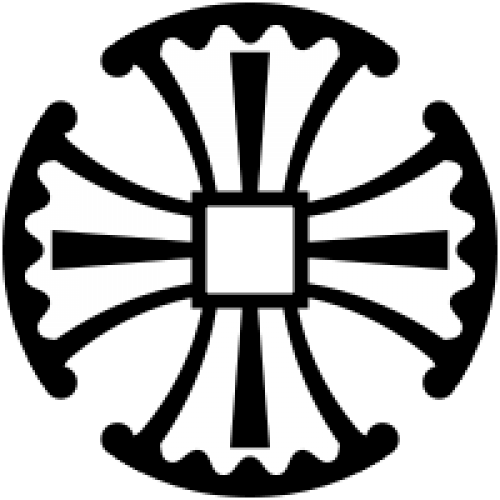In this section we acknowledge the faith and commitment of the founding members of this parish. Their love of God and sheer hard work have given us a rich heritage on which to build our own faith. Here you will find background on just a few of these people along with pictures of objects that can be found around the church that memorialise their contribution.
Thomas Stanford & Elizabeth Roscoe
It is understood that the first Anglican services in Wadestown were held in the Roscoe’s home. Roscoe Terrace is named after them. The Roscoes continued their active involvement once the St Paul’s Churchroom was built. Thomas was the first layreader and Elizabeth the first organist. They returned to live in England in 1902.

The plaque on the font is in memory of Thomas Roscoe. The pulpit is also dedicated to the Roscoes.
Rev. Dr. Bache Wright Harvey
Dr. Harvey came to New Zealand in 1858. He was vicar of St. Paul’s, Wellington from 1872 to 1882. It was through his vision and energy that the St. Paul’s Churchroom was built in Blackbridge Road, Wadestown. It opened on October 2, 1881.

Rev. Thomas Sprott
Thomas Henry Sprott was the vicar of St Paul’s when the Churchroom was moved from Blackbridge Road to Pitt Street. At this time the clergy of St Paul’s were responsible for services and providing priestly duties in Wadestown and he believed strongly that Wadestown needed its own resident clergyman. The local committee however seemed less convinced. It appears that the terms of the stipends and guarantees were a major stumbling block. The process took a couple of years and it was due to a great deal of tenacity on the part of Rev. Sprott that the local committee finally agreed to guarantee £90 a year for two years toward the stipend. The first resident clergyman, the Rev. P. T. Fortune, took up his position in 1900.

Rev. Sprott went on to become the Bishop of Wellington, a position he held for nearly 25 years.
Sarah Anne Rhodes
Sarah Rhodes was a parishioner and benefactor in the early days of St Luke’s. Born Sarah Anne Moorhouse she married William Barnard Rhodes (an early businessman) in 1869. Sar St is named after her (S.A.R. being her initials) as is Anne St (her middle name). Moorhouse St and Sefton Sts are said to be named after her brother – William Sefton Moorhouse and Barnard (as in Barnard St) was her husband’s middle name. Sarah Rhodes contributed a significant amount to the fund for the church building we now know as St Luke’s.
Sir James Trevilly Grose
Sir James was an active member of the church and was for some years a vicar’s warden. He was an enthusiastic supporter of getting a pipe organ for St. Luke’s but died shortly before this eventuated. When the organ finally arrived, in much need of a refit, his daughter Melicent Saunders donated the new console as a memorial to her father.

Rev. T. B. G. Kay
Rev. Kay was appointed as assistant curate of St. Paul’s with special charge of Wadestown in 1903. The following year Wadestown, Northland and Creswick were designated a separate parochial district with Rev. Kay the first vicar. It was through his enthusiasm and leadership that the church we now know as St. Luke’s Wadestown was built. The building fund was established with a donation of £80 0s 2d in December 1903 and the church was consecrated in March 1909.


The tablet in the chancel remembers Rev. Kay and his contribution to the building of the church.
Ellen Martha Lomas
Ellen Lomas was a parishioner of St. Luke’s from its earliest beginning until her death in 1958. The beautiful stained-glass window depicting the annunciation is a memorial to her.

Lowe family
Edward William Lowe was a pioneer of St. Luke’s. He was a member of the first church committee and the first vestry elected in 1897. He was also the first vicar’s warden. In May 1919 land for the parish hall was purchased from him for the price of £200. His sister Ada Mary Lowe was superintendent of the Sunday School for many years and a member of the choir until her death at the age of 75. Edward and Ada are remembered on separate plaques in the church.


Rev. Harry Coleridge Arnold
Rev. Arnold came to St Luke’s in 1957. He was a much-loved vicar who saw St. Luke’s attain full parish status in 1960. Sadly he was diagnosed with cancer to which he succumbed in February 1969. Up until the very end he continued to serve and inspire others.
There is a prayer desk in the chapel dedicated to his memory.


Withers family
The Withers family have a long history of involvement with St. Luke’s. William Withers was the architect who designed the original vicarage and his son Bernard was choirmaster for many years. He was also Vicar’s warden 1913-1914 and 1930-1934. Bernard’s wife Geraldine was very involved in youth work in the parish and his daughter Mollie was the organist for many years. Jack Withers (son of Bernard and grandson of William) followed the family tradition and was a prominent layman and supporter of St. Luke’s.

Other pioneers
There were of course many other individuals and families that contributed to the early development of St Luke’s. Names that crop up again and again in vestry minutes and other old documents include Rowe, Skilton, Peebles and Liggins to name but a few. Some are acknowledged in memorial plaques around the church; others are not. We thank them all for the legacy they left behind.

